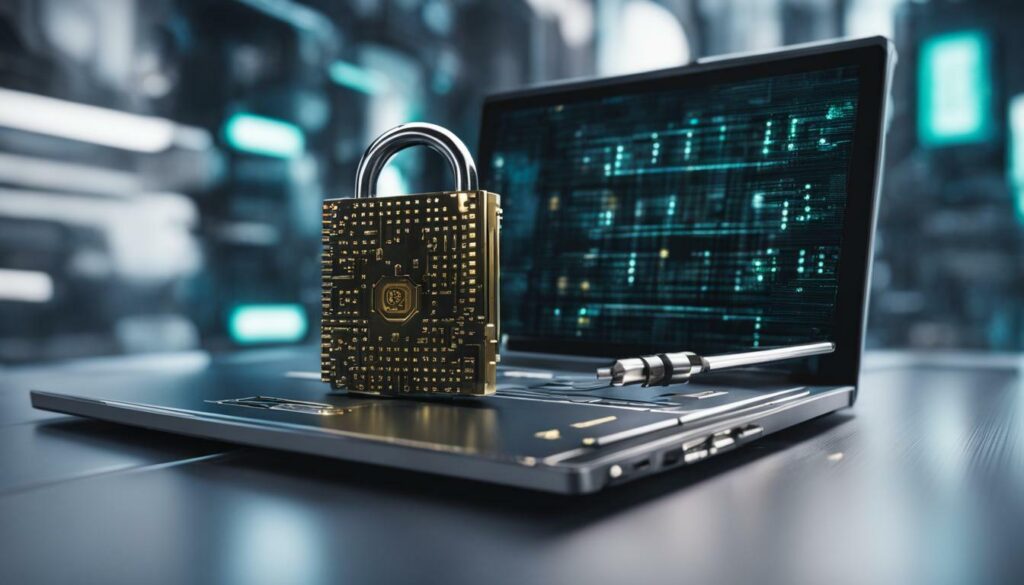Protecting your code signing certificate’s private key is crucial to ensure the trust and integrity of your signed software. Implementing proper security measures is essential to prevent the compromise of your private key, which can lead to potential risks and undermine the value of your certificate.
Code signing is a powerful method used by software developers to prove the authenticity of their code and protect against malware. However, without adequate protection for the private key, the code signing certificate becomes vulnerable to unauthorized access and misuse.
Why Is It Important to Protect Code Signing Private Keys?
The security of your code signing certificate relies heavily on the protection of the private key associated with it. If this key is compromised, the trust and value of the certificate are at stake, potentially endangering the software you have signed. To prevent this, it is crucial to minimize access to private keys and implement physical security controls to reduce the risk of unauthorized access.
How Do You Implement Code Signing?
To implement code signing, you need a properly hashed unique private key that ensures the encryption and decryption process cannot be easily defeated. The process involves generating a new key pair using public key infrastructure (PKI), submitting the public key to a certificate authority for verification, and receiving back the code signing certificate with the appended public key. The signed certificate and encrypted code are then combined into the software after hashing the code, creating a signature block.
Top 5 Code Signing Best Practices
Here are the top five best practices for protecting your code signing certificate keys:
- Minimize access to private keys and implement physical security controls.
- Develop a culture of secure code signing practices within your organization to avoid careless habits.
- Use cryptographic hardware products to safeguard your private keys.
- Time-stamp your code to ensure its validity even after the certificate has expired or been revoked.
- Authenticate your code before signing and releasing it to ensure it is free from malicious elements.
Reducing & Controlling Your Private Key Access
One of the most significant security threats is the compromise, loss, or unauthorized access to the private key of your code signing certificate. To mitigate this risk, it is crucial to minimize access to private keys and implement physical security controls to prevent unauthorized individuals from gaining access to them.
Avoid Creating Bad Habits
Properly using code signing certificates within your system is essential, but it is equally important to develop a culture that understands and values the application and importance of code signing. By avoiding careless habits and promoting secure code signing practices, you can enhance your organization’s overall security.
Protect Private Keys with Cryptographic Hardware
Safeguarding private keys using cryptographic hardware provides an extra layer of protection against malicious actors. By using certified cryptographic hardware products, you can prevent the compromise of your private keys and ensure the security of your code signing process.
Time-Stamp Code
Time-stamping your code allows you to establish the date and time of code creation, ensuring its validity even after the certificate has expired or been revoked. This helps maintain the integrity of your signed code and protects against potential vulnerabilities as technology and cryptographic threats evolve.
Authenticate Code
Code signing alone does not guarantee the safety of code. It is crucial to authenticate code before signing and releasing it to ensure it is free from any malicious elements. Implementing proper authentication processes and documenting them for future reference enhances the security of your code signing activities.
Give Your Organization an Extra Security Boost
Implementing code signing best practices not only protects your code but also enhances your organization’s overall security. By safeguarding your code signing certificate keys, you can maintain the trust and integrity of your software, avoiding potential risks and maintaining your reputation.
Conclusion
Protecting your code signing certificate’s private key is of utmost importance to ensure the security of your code. By implementing best practices such as minimizing access to private keys, using cryptographic hardware, time-stamping code, and authenticating code, you can enhance your organization’s overall security and safeguard your digital assets.
Why Is It Important to Protect Code Signing Private Keys?
The protection of code signing keys is paramount to maintain the trustworthiness of your code and prevent potential security breaches. When a code signing certificate is used to sign code, it ensures that the code originates from a trusted and legitimate source and hasn’t been tampered with. Code signing acts as a powerful security measure, guaranteeing the authenticity and integrity of the code.
However, the most significant issue with code signing is the protection of the private key associated with the code signing certificate. If this private key is compromised, it can undermine the trust and value of the certificate, endangering the software that has been signed.
Recent malware attacks, such as Stuxnet, have demonstrated the potential risks of compromised code signing keys. Malicious actors have used legitimate code signing certificates to sign malware, exploiting the trust associated with signed code. These incidents highlight the importance of implementing robust security measures to protect code signing keys.
To safeguard code signing keys, organizations should follow best practices and employ various security measures. These measures include minimizing access to private keys, using cryptographic hardware products, time-stamping code, and authenticating code before signing and releasing it.
In the next sections, we will explore these best practices in detail and discuss how they contribute to the protection of code signing keys and the overall security of your code.
Why Is It Important to Protect Code Signing Keys?
The most significant issue with code signing is protecting the private code signing key linked with the code signing certificate. If the private key is compromised, the certificate suffers trust and value, endangering the software you have signed.
The importance of protecting code signing keys cannot be overstated. When a code signing certificate is compromised, it not only puts the trustworthiness of the signed code at risk, but it also damages the reputation and credibility of the organization behind the certificate. The consequences of a compromised key can be severe, leading to financial losses, legal liabilities, and loss of customer trust.
Therefore, organizations must implement robust security measures to protect their code signing keys. These security measures can help prevent unauthorized access to the private keys and ensure that only trusted individuals with proper authentication can use them for code signing purposes.
By implementing the following best practices, organizations can significantly enhance the security of their code signing keys and mitigate the risks associated with key compromise:
Minimize access to private keys
One of the most crucial security measures is to minimize access to private keys associated with code signing certificates. The fewer individuals with access to these keys, the lower the risk of compromise.
Organizations should implement strict access controls and restrict the number of users who have access to private keys. Physical security controls should also be used to further reduce access to private keys, such as storing them in secure vaults or cryptographic hardware modules.
Protect private keys with cryptographic hardware products
Cryptographic hardware products provide an extra layer of protection for code signing keys. These hardware products prevent the export of private keys to software environments where they could be vulnerable to attacks.
Organizations should consider using FIPS 140 Level 2-certified cryptographic hardware products or better to protect their private keys. These hardware modules ensure that the keys are securely generated and stored, reducing the risk of unauthorized access.
Time-stamp code
Time-stamping code is an essential practice for ensuring the validity of signed code, even after the code signing certificate has expired or been revoked. Time-stamping allows the code to be reverified based on the timestamp, providing assurance that the code was signed at a specific time and has not been tampered with since then.
By time-stamping code, organizations can maintain the integrity and trustworthiness of their signed code, even in scenarios where the certificate has expired or been compromised.
Authenticate code
Code signing alone does not guarantee the safety or quality of code. It simply verifies the identity of the publisher and confirms that the code has not been modified since being signed. To ensure the code’s authenticity and safety, organizations should authenticate the code before signing and releasing it.
Implementing a code signing submission and approval process can help prevent the signing of unapproved or malicious code. It is essential to verify the source and integrity of the code to protect customers and maintain the organization’s reputation.
By following these best practices, organizations can significantly enhance the security of their code signing keys and mitigate the risks of compromise. Protecting code signing keys should be a top priority to maintain the trust and integrity of your code.
Next, we will explore additional best practices for code signing, including reducing and controlling private key access, avoiding bad habits, and giving your organization an extra security boost.

How Do You Implement Code Signing?
Implementing code signing involves generating a unique private key, obtaining a code signing certificate, and encrypting and signing your code. This process ensures the integrity and authenticity of your software, making it trusted by users.
Here is a step-by-step guide on how to implement code signing:
- Obtain a code signing certificate: Once you have your private key, you need to obtain a code signing certificate from a trusted certificate authority (CA). The CA will verify your identity as a developer and issue a certificate that will be used to sign your code.
- Encrypt and sign your code: After receiving your code signing certificate, you can now proceed to encrypt and sign your code. Hash your code to create a unique digest, then encrypt it using your private key. This process ensures that any modifications made to the code after signing will be detected.
- Embed the signature: Once your code is encrypted and signed, you need to embed the signature into your software. This can be done by combining the signed code with the code signing certificate and the hash function used to create the signature block.
- Include a time-stamp: It is recommended to include a time-stamp in your code signing process. This allows users to verify the validity of the signed code even after the code signing certificate has expired or been revoked. Time-stamping ensures that the code remains trusted and valid over time.
By following these steps, you can successfully implement code signing and enhance the security and trustworthiness of your software.
Top 5 Code Signing Best Practices
To ensure the security of your code signing certificate keys, it is important to follow these top five best practices:
- Reducing & Controlling Your Private Key Access: One of the most significant security threats is compromising, losing, or exfiltrating the private key of a code signing certificate. It’s pretty alluring to hackers due to malicious actors’ freedom to sign any code, anywhere. To avoid losing a private key, make sure to allow minimum access to private keys. Physical security controls must be used to reduce access to private keys.
- Avoid creating bad habits: It is essential to use the code signing certificates within your system properly. However, if behavioral patterns are not enforced to maintain and properly use the keys, then no matter what practices you employ, it will be useless. Try developing a culture where people understand the application and importance of code signing and different types of certificates. This can only improve your organizational security as a whole.
- Protect private keys with cryptographic hardware: You can use cryptographic hardware that basically allows you to protect your private keys with the latest encryption algorithms. This type of hardware protects your private keys from falling into the hands of malicious actors. You can use a FIPS 140 Level 2-certified product (or better) or use a service like Certum SimplySign – Code Signing in the Cloud.
- Time-stamp code: Time-stamping your code allows you to recognize when code was written of the certificate it uses. This allows the code to be reverified as a legitimate one, in case the certificate is expired or revoked. This helps recognize the exact date and time as the level of protection can be weakened or outright broken as technology and cryptographic threats evolve.
- Authenticate code: Code signing does not explicitly identify code as safe; however, it states who wrote it and when it is published. The code, even after signing, needs to be fully authenticated before it can be released to the public in good faith. By following proper authentication steps, the developers and users can ensure that the code doesn’t contain malicious data that can harm customers and damage your reputation. All authentication procedures of the code signing activities should be documented for posterity in case of a probable investigation or incident.
Reducing & Controlling Your Private Key Access
Minimizing the access to private keys and implementing strict access control measures is essential to protect your code signing certificate keys. The private key associated with a code signing certificate is a highly valuable asset that, if compromised, can lead to trust and security issues for your software. To ensure the security of your private keys, consider the following best practices:
- Allow minimum access to private keys: Limit access to computers or systems with private key access to only those individuals who absolutely need it. By minimizing the number of users with access, you reduce the chances of unauthorized use or compromise.
- Use physical security controls: Implement physical security measures such as secure vaults or Hardware Security Modules (HSMs) to protect your private keys. These measures can help prevent unauthorized physical access to the keys and provide an extra layer of security.
By implementing strict access control measures and minimizing access to private keys, you can significantly reduce the risk of private key compromise and enhance the overall security of your code signing process.

“The biggest issue with code signing is the protection of the private signing key associated with the code signing certificate. If a key is compromised, the certificate loses trust and value, jeopardizing the software that you have already signed.”
Developing a culture of secure code signing practices and avoiding bad habits can significantly enhance the security of your code signing process.
When it comes to code signing, implementing best practices is crucial to ensure the integrity and trustworthiness of your software. By following secure code signing practices, you can protect your code signing certificate keys and safeguard your digital assets from potential threats. Here are some key practices to consider:
- Minimize access to private keys: One of the most important steps in protecting your code signing certificate keys is to limit access to them. Only provide access to individuals who truly need it and implement physical security controls to reduce the risk of unauthorized access.
- Avoid creating bad habits: It’s not enough to simply have code signing certificates in place. Developing a culture within your organization where employees understand the importance of code signing and follow proper practices is essential. Encourage good habits and ensure that everyone understands the significance of code signing and the different types of certificates available.
- Protect private keys with cryptographic hardware: Using cryptographic hardware can provide an extra layer of protection for your private keys. This hardware utilizes advanced encryption algorithms to safeguard your keys from falling into the wrong hands. Consider using FIPS 140 Level 2-certified products or better, or using an EV code signing certificate that requires the private key to be generated and stored in hardware.
- Time-stamp code: Time-stamping your code is crucial for ensuring its validity even after the code signing certificate has expired or been revoked. By adding a time stamp to your signed code, you can verify when the code was written and validate it as legitimate, providing additional reassurance to users.
- Authenticate code: Code signing does not guarantee the safety of the code itself, but rather verifies the identity of the publisher and the integrity of the code. It is important to authenticate the code before signing and releasing it to ensure it does not contain any malicious elements. Implement a code signing submission and approval process and log all code signing activities for auditing and incident-response purposes.
By following these code signing best practices, you can give your organization an extra security boost and protect your code and digital assets from potential threats. Remember, securing your code signing certificate keys is crucial for maintaining the trust and integrity of your software.
“The most significant issue with code signing is protecting the private code signing key linked with the code signing certificate. If the private key is compromised, the certificate suffers trust and value, endangering the software you have signed.”
Revoking compromised certificates
It is important to promptly report any key compromise or signed malware to your certification authority. If a code signing certificate is compromised, it should be revoked to prevent the signing of unapproved or malicious code. Additionally, make sure your code signing certificates are regularly changed to distribute the risk and avoid conflicts with compromised keys.

Following these best practices can help ensure the security of your code signing process and protect your software from potential threats. By developing a culture of secure code signing practices and avoiding bad habits, you can maintain the trust of your users and safeguard your digital assets.
Protecting private keys with cryptographic hardware
Protecting your private keys with cryptographic hardware provides an additional layer of security to mitigate the risk of key compromise. Cryptographic hardware, such as FIPS 140 Level 2-certified products, allows you to safeguard your private keys using the latest encryption algorithms.
By storing your private keys in cryptographic hardware, you prevent them from being exposed to software attacks or unauthorized access. Cryptographic hardware ensures that the private key cannot be exported to software where it could be targeted by malicious actors.
When selecting cryptographic hardware, it is important to choose a product that meets the necessary security standards. Look for FIPS 140 Level 2-certified products or better, as they are designed to provide a high level of protection for your private keys.
In addition to using cryptographic hardware, it is recommended to generate and store the private key in hardware for an Extended Validation (EV) code signing certificate. This adds an extra layer of security by requiring the private key to be generated and stored within the cryptographic hardware.
“Protecting private keys with cryptographic hardware is crucial for ensuring the integrity and trustworthiness of code signing certificates. By using FIPS 140 Level 2-certified products or better and storing private keys in hardware, organizations can significantly reduce the risk of key compromise and unauthorized access.”
By implementing cryptographic hardware to protect your private keys, you add an extra level of security to your code signing process. This ensures that only authorized individuals can access and use the private keys, reducing the risk of key compromise and unauthorized code signing.
Benefits of using cryptographic hardware for private key protection:
- Prevents private keys from being exposed to software attacks
- Reduces the risk of unauthorized access to private keys
- Meets necessary security standards, such as FIPS 140 Level 2
- Enhances the overall security of code signing certificates
By adopting cryptographic hardware to protect your private keys, you can safeguard your code signing certificates and ensure the integrity of your code. This extra layer of security helps protect your organization’s digital assets and maintain the trust of your customers and users.

Protecting private keys with cryptographic hardware is a crucial step in implementing secure code signing practices. By using hardware-based encryption and storage, you can significantly reduce the risk of key compromise and enhance the overall security of your code signing certificates.
Time-stamping your code
Time-stamping your code provides an essential measure to verify its authenticity and integrity, even if the code signing certificate is no longer valid. By adding a time-stamp to the code, you can ensure that the code can be reverified as legitimate, even if the certificate used to sign the code expires or is revoked.
To implement time-stamping, you need to obtain a time-stamp certificate. This certificate is issued by a trusted time-stamping authority and contains a trusted timestamp with the exact date and time of when the code was signed.
By including a time-stamp, you can ensure that your code remains valid beyond the expiration or revocation of the code signing certificate. This is particularly important as technology and cryptographic threats evolve over time.
Why is time-stamping important?
Time-stamping code provides several benefits:
- Code validity: With a time-stamp, you can verify the validity of your code at any point in time, even if the certificate has expired or been revoked.
- Legal protection: Time-stamps provide legal evidence of the existence and integrity of your code at a specific point in time, which can be crucial in case of disputes or litigation.
- Evidence of authenticity: Time-stamps provide proof that your code was signed at a specific time, adding an additional layer of trust and assurance to your users.

Implementing time-stamping is essential for ensuring the long-term validity and integrity of your signed code. By including a trusted time-stamp, you can provide assurance to your users that your code is authentic and has not been tampered with, even if the certificate used to sign it has expired or been revoked.
Authenticate code before signing and releasing it
Authenticating code before signing and releasing it is crucial to ensure that your software is free from any potential threats and maintains its integrity. Code signing provides assurance to users that the software they are installing is from a trusted source and has not been tampered with. However, simply signing code without proper authentication measures can lead to the distribution of malicious or vulnerable software.
Before signing code, it is important to implement a thorough code authentication process. This process should verify that the code is free from any malicious elements and adheres to the organization’s security standards. By following proper authentication steps, developers and users can ensure that the code they sign and release is safe and trustworthy.
Here are some best practices to consider when authenticating code:
- Implement a code signing submission and approval process: Before code is signed, it should go through a submission and approval process. This process ensures that only authorized code is signed and released. It can involve reviewing the code for potential vulnerabilities, conducting security scans, and verifying the identity of the code author.
- Log all code signing activities: It is essential to maintain a log of all code signing activities for auditing and incident-response purposes. This log can help track the history of code signing activities, identify any potential security breaches or anomalies, and aid in investigations if needed.
- Regularly update code signing certificates: Code signing certificates should be regularly updated to maintain their validity and security. This includes renewing certificates before they expire and revoking compromised certificates. Regularly updating certificates reduces the risk of using outdated or compromised keys for code signing.
- Implement virus scanning: Before signing code, it is important to conduct virus scans to detect any malicious software or potential threats. Virus scanning helps ensure that the code being signed is free from malware and meets security standards.
By following these best practices, organizations can enhance the security and integrity of their code signing process. Authenticating code before signing and releasing it not only protects users from potential risks but also safeguards the organization’s reputation and trustworthiness.

Implementing a robust code authentication process is a crucial component of secure code signing. By taking the necessary steps to verify the integrity and safety of the code before signing and releasing it, organizations can ensure that their software is free from potential threats and maintains the trust of their users.
Next section: Give your organization an extra security boost
Give your organization that extra security boost
By adopting and implementing code signing best practices, you can give your organization an extra security boost and safeguard your digital assets effectively. Code signing is a critical step in ensuring the authenticity and integrity of your software. It provides assurance to users that the code they are installing is from a trusted source and has not been tampered with.
Minimize access to private keys
One of the most important steps in protecting code signing certificate keys is to minimize access to private keys. Limiting access to only essential personnel reduces the risk of unauthorized use or compromise. Implement physical security controls such as secure vaults or hardware security modules to further safeguard private keys.
Avoid creating bad habits
Developing a culture of secure code signing practices within your organization is essential. Ensure that employees understand the importance of code signing and the different types of certificates. Educate them on the proper usage and handling of code signing keys to enhance your organizational security as a whole.
Protect private keys with cryptographic hardware
Using cryptographic hardware can significantly enhance the protection of your code signing private keys. These hardware devices provide secure storage and prevent the keys from being accessed by malicious actors. Look for FIPS 140 Level 2-certified products or better, or consider using an EV code signing certificate that requires the private key to be generated and stored in hardware.
Time-stamp code
Time-stamping your code adds an extra layer of validation and ensures the longevity of your signed code. By including a time-stamp, you can verify the code even after the certificate has expired or been revoked. This helps maintain code validity and protects against potential issues due to certificate expiration or revocation.
Authenticate code
Before signing and releasing code, it is crucial to authenticate it thoroughly. Implement a code signing submission and approval process to ensure that only approved and safe code is signed. By following proper authentication steps, you can protect your customers from potential harm and preserve your organization’s reputation.

Implementing code signing best practices not only enhances the security of your code but also strengthens your overall organizational security. By taking these measures, you can protect your digital assets effectively and mitigate the risk of code tampering and malicious attacks.
Protecting Code Signing Certificate Keys – Safeguarding Your Digital Assets
Protecting your code signing certificate’s private key is crucial to ensure the authenticity and trustworthiness of your signed code, and implementing the recommended security measures is essential to safeguard your digital assets. Code signing is a powerful method to secure your code, proving its authenticity and protecting against tampering.
However, the most significant vulnerability lies in the protection of the private key associated with your code signing certificate. If the private key is compromised, the trust and value of the certificate are jeopardized, putting the software you have signed at risk.
Minimizing access to private keys is one of the top code signing best practices. By allowing minimal access to computers with keys and implementing physical security controls, you can reduce the chances of unauthorized access to your private keys.

Another crucial step is to protect your private keys with cryptographic hardware. Using FIPS 140 Level 2-certified products or better ensures that your private keys are stored securely and are not vulnerable to attacks. Cryptographic hardware prevents the export of private keys to software, effectively safeguarding your keys from malicious actors.
Time-stamping code is also essential for code validity. By time-stamping your code, you can verify its legitimacy even after the code signing certificate has expired or been revoked. This ensures that your signed code remains trusted and credible.
Authenticating code before signing and releasing it is another important practice. Code signing does not guarantee the safety of the code itself; it verifies the identity of the publisher and whether the code has been modified. By implementing a code signing submission and approval process, you can prevent the signing of unapproved or malicious code.
Preventing bad habits and developing a culture of secure code signing practices within your organization is crucial. Educating your team about code signing and the importance of different types of certificates helps strengthen your overall organizational security.
By following these code signing best practices, you can give your organization an extra security boost. Implementing these measures enhances your overall security posture and protects your digital assets from potential threats.
“Protecting your code signing certificate’s private key is crucial to ensure the authenticity and trustworthiness of your signed code, and implementing the recommended security measures is essential to safeguard your digital assets.”
In conclusion, protecting your code signing certificate keys is vital for the security of your code and digital assets. Minimizing access to private keys, using cryptographic hardware, time-stamping code, and authenticating code are all key practices that help ensure the integrity and trustworthiness of your signed code. By implementing these measures, you can safeguard your digital assets and enhance your organization’s overall security.
If you have any concerns or questions about code signing certificate security, our team at [Company Name] is here to help. Contact us at [Sales Email Address] to schedule a meeting and discuss how we can support your organization’s security needs.
Protecting Code Signing Certificate Keys – Safeguarding Your Digital Assets
Protecting code signing certificate keys is not only crucial for maintaining trust and integrity but also for safeguarding your organization’s valuable digital assets from potential security threats. Code signing certificates are used to authenticate software and ensure that it has not been tampered with since it was signed. However, the private key associated with the code signing certificate is the most critical component that needs protection. If the private key is compromised, the entire certificate becomes vulnerable, putting your signed software at risk.
There are several best practices that organizations can implement to enhance the security of their code signing certificate keys and protect their digital assets:
- Minimize access to private keys: It is essential to restrict access to private keys to a minimum number of trusted individuals. Implement physical security controls to reduce the risk of unauthorized access.
- Avoid creating bad habits: Developing a culture of secure code signing practices within your organization is crucial. Educate employees about the importance of code signing and the types of certificates being used to improve organizational security.
- Protect private keys with cryptographic hardware: Utilize cryptographic hardware products to safeguard private keys from being exposed. These hardware devices prevent the export of private keys and ensure they are stored securely.
- Time-stamp code: Time-stamping code allows verification of the software’s authenticity even after the certificate’s expiration or revocation. This helps maintain the integrity of the signed code in the long term.
- Authenticate code: Before signing and releasing code, ensure it goes through a thorough authentication process. This reduces the risk of including malicious elements in the signed code and protects your customers from potential harm.
Implementing these best practices will give your organization an extra security boost and help safeguard your valuable digital assets. By following these guidelines, you can enhance the overall security of your code signing process and protect against potential threats.
For further assistance in implementing code signing best practices and ensuring the security of your organization, contact our experienced team at sales-in@globalsign.com. We are here to help you safeguard your digital assets and maintain the trust of your customers.
FAQ
Q: Why is it important to protect code signing keys?
A: Protecting code signing keys is crucial because if the private key linked to the code signing certificate is compromised, it can endanger the trust and value of the certificate. This puts the software at risk and can damage the reputation of the signer.
Q: How do you implement code signing?
A: To implement code signing, you need a unique private key that is securely hashed. The public key is then sent to the certificate authority for verification. Once the certificate and code are returned, the developer hashes the software’s code, encrypts it using the private key, and combines it with the code-signing certificate to create a signature block that can be embedded into the software.
Q: What are the top 5 code signing best practices?
A: The top 5 code signing best practices include reducing and controlling private key access, avoiding bad habits when using code signing certificates, protecting private keys with cryptographic hardware, time-stamping code for validation, and authenticating code before releasing it.
Q: How can I reduce and control private key access?
A: To reduce and control private key access, limit connections to computers with keys, minimize the number of users with key access, and use physical security controls to restrict access to keys.
Q: How can I protect private keys with cryptographic hardware?
A: To protect private keys, you can use cryptographic hardware that prevents the export of the key to software where it can be attacked. Use a FIPS 140 Level 2-certified product or better and ensure the hardware is protected with a strong password.
Q: Why is time-stamping code important?
A: Time-stamping code allows for verification of code even after the certificate has expired or been revoked. This ensures that the code remains valid and trusted even as technology and threats evolve.
Q: How can I authenticate code before signing?
A: To authenticate code before signing, implement a code signing submission and approval process to prevent the signing of unapproved or malicious code. Log all code signing activities for auditing and incident-response purposes.
Q: How can implementing code signing best practices enhance organizational security?
A: Implementing code signing best practices provides an extra security boost to an organization by protecting its digital assets, maintaining the integrity of software, and ensuring that code released to the public is safe and trustworthy.
Q: How can I protect my code signing certificate from a security breach?
A: To protect a code signing certificate from a security breach, follow best practices such as minimizing access to private keys, using cryptographic hardware, time-stamping code, authenticating code, and regularly revoking compromised certificates.
Q: Why is it important to log all code signing activities?
A: Logging all code signing activities is important for auditing and incident-response purposes. It allows organizations to track and investigate any suspicious or unauthorized code signing activities.






